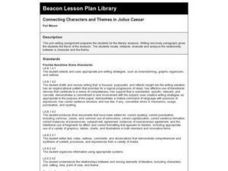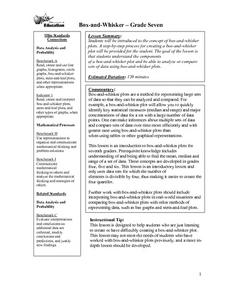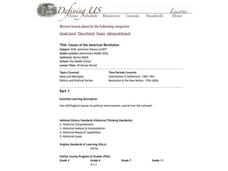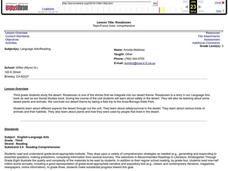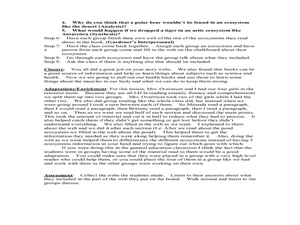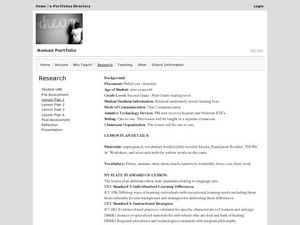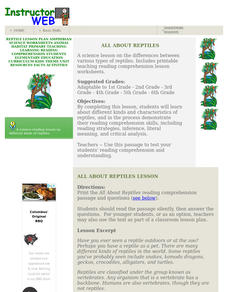Curated OER
Connecting Characters and Themes in Julius Caesar
Fourth graders prepare for the literary analysis. They locate, interpret, evaluate and analyze the relationship between a character and the theme. After a lecture/demo, 4th graders write topic and detail sentences, then correctly put...
Curated OER
Box-and-Whisker
Seventh graders are introduced to the concept of box-and-whisker plots. A step-by-step process for creating a box-and-whisker plot is provided. The goal of the lesson is that students study the components of a box-and-whisker plot and be...
Curated OER
Buoyant Force
Students investigate the scientific concept of why some objects float when put in a liquid solution. They apply the laws of motion and force while conducting classroom activities. Students also take notes and answer target questions to...
Curated OER
Causes of the American Revolution
Learners answer the question of: How did England impose its political and economic control over the colonies? They create a comic strip depicting the event of the Boston Massacre. Students complete a Wordstoming activity to anticipate...
Curated OER
How Do They Relate? Linear Relationship
Students collect information and use a line to represent it. In this algebra lesson, students investigate real world data to see if it makes a line. They graph the line comparing the relationship of the x axis with that of the...
Curated OER
The Poet's Message-"The Colored Soldier" by Langston Hughes
Students analyze the poem, "The Colored Soldier" by Langston Hughes to gain a greater experience of how poets use language to create meaning, influence thinking and thus become pioneers of change in American society. They work on the...
Curated OER
Mushrooms Can Save the World
Middle schoolers use mushrooms to solve problems. In this environmental lesson, students study how fungi have been used to combat environmental problems. Middle schoolers design strategies that employ mushrooms to combat other...
Curated OER
Problem Solving and the Sports Page
Fourth graders create and solve word problems using the boxscores from the sports section of the newspaper. The role play the sport, define abbreviations used and examine the fundamentals of scoring the sport.
Curated OER
PLANETS IN PROPORTION
Students discover scales for both the solar bodies' relative sizes and their distances from the sun. They find equatorial circumference and volumes of their solar bodies. Students apply estimation strategies and proportioanl reasoning to...
Curated OER
Roxaboxen
Third graders discuss the story "Roxaboxen." In this reading comprehension activity, 3rd graders discover new vocabulary words, discuss the story using story mapping, and take a reading test. Students investigate safety in the desert and...
Curated OER
Nonviolent Conflict Resolutions with Cesar Chavez
Third graders investigate nonviolent conflict resolution strategies. In this interpersonal communication lesson, 3rd graders explore conflict resolution. Students construct a newspaper/magazine article detailing nonviolent conflict...
Curated OER
"Texas T"
Students examine how the discovery of oil replaced cotton and changed the Texas economy from agricultural to industrial. They read primary source documents, define key vocabulary terms, and create a bookmark.
Curated OER
One Hundred Hungry Ants
Primaries read the book One Hundred Hungry Ants and solve word problems based on the book. In this word problems lesson plan, students will be able to find the factors of a number by organizing counters into equal rows.
Curated OER
How Many More on a Graph?
First graders examine data on a graph and determine which variable on the graph has more. They draw pictures of their family members and determine which families have more members than other families. Using squares of paper to depict...
Curated OER
Transportation Through Time
Third graders measure the speed at which they can walk in order to understand speed and distance traveled. They then research the history of transportation and express data in a class timeline.
Curated OER
Pre- and Post-Reading Plan
Students are introduced to pre- and post-reading strategies. Individually, they read excerpts of a story while making predictions about what they believe is going to happen next. After reading the selection, they answer comprehension...
Curated OER
Magnet Poetry
Students engage in a lesson that involves the use of imagery in poetry. They select words from poems that are used for imagery. The words are put onto magnets and then used to create new poems filled with imagery. The hands on connection...
Curated OER
CATCH, TAG and RELEASE
Students apply estimation strategies for problem-solving purposes. They become familiar with one aspect of a marine biologist's work.
Curated OER
Cesar Chavez Biopoem
Students demonstrate their learning about Cesar Chavez and the United Farm Workers Union by writing a biopoem. They word process the poem.
Curated OER
An Explication of Death
Fourth graders, in groups, analyze portions of William Cullen Bryant's poem, "Thanatopsis." They present their analysis to the class and discuss the meaning of the poem as a whole. They also identify the poetic elements present in the...
Curated OER
Graphic Organizers Aid Comprehension
Students create story webs to aid comprehension of ecosystems. In this reading strategies lesson, students discover the importance of organizing information while reading a nonfiction text. Students produce story webs to communicate...
Curated OER
Fill Me In
Second graders work on expanding their vocabulary. In this personal writing lesson, 2nd graders practice word identification and complete a worksheet by filling in the blanks.
Curated OER
All About Reptiles
Young scholars examine different kinds and characteristics of reptiles, and demonstrate reading comprehension skills, including reading strategies, inference, literal meaning, and critical analysis.
Curated OER
INTRODUCTION TO THE PERIODIC TABLE
Students identify the scientist who first wrote the Periodic Table, identify the scientist who amended the Table, state (or write) specific data relating to the history of the Periodic Table, identify at least five elements, and two...
